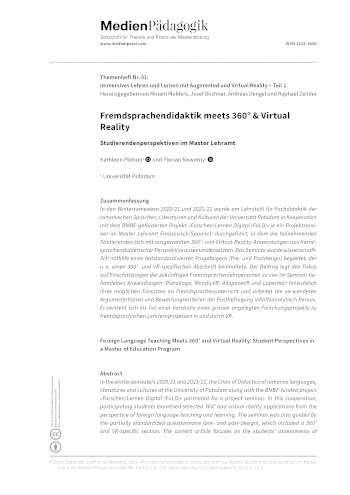Abstract
In the winter semesters 2020/21 and 2021/22, the Chair of Didactics of romance languages, literatures and cultures at the University of Potsdam along with the BMBF-funded project «Forschen/Lernen Digital (FoLD)» partnered for a project seminar. In this cooperation, participating students examined selected 360° and virtual reality applications from the perspective of foreign language teaching and learning. The seminar was also guided by the partially standardized questionnaire (pre- and post-design), which included a 360° and VR-specific section. The current article focuses on the students’ assessments of four applications used in the seminar (Panolingo, MondlyVR, AltspaceVR, and Lapentor) regarding their possible implementation in the foreign language classroom and elaborates on the argumentations and evaluation criteria given by the future teachers in the second survey (post design). It is part of a preliminary study of a larger research project on foreign language teaching and learning processes in and through VR.
References
Campbell-Howes, Kirsten. 2017. «Let’s Game: Busuu Taps into Virtual Reality». Busuu Blog (blog). 26. Oktober 2017. https://blog.busuu.com/lets-game-busuu-taps-virtual-reality/.
Frazier, Erin, Ryan Lege, und Euan Bonner. 2021. «Making Virtual Reality Accessible for Language Learning: Applying the VR Application Analysis Framework». Teaching English with Technology 21: 128–40.
Kipman, Alex. 2022. «Making AltspaceVR a Safer Space». AltspaceVR. 16. Februar 2022. https://altvr.com/making-altspacevr-a-safer-space/.
Klötzke, Ralf. 2021. «Virtual Tour (360) ZUM Edition – neuer H5P-Inhaltstyp auf ZUM-Apps». 7. Juni 2021. https://www.zum.de/portal/virtual-tour-360-zum-edition-neuer-h5p-inhaltstyp-auf-zum-apps/.
Kuckartz, Udo. 2018. Qualitative Inhaltsanalyse: Methoden, Praxis, Computerunterstützung. 4. Auflage. Grundlagentexte Methoden. Weinheim, Basel: Beltz Juventa.
Kultusministerkonferenz. 2021. «Lehren und Lernen in der digitalen Welt: Die ergänzende Empfehlung zur Strategie ‹Bildung in der digitalen Welt›». https://www.kmk.org/fileadmin/veroeffentlichungen_beschluesse/2021/2021_12_09-Lehren-und-Lernen-Digi.pdf.
Lan, Yu-Ju. 2020. «Immersion, Interaction, and Experience-Oriented Learning: Bringing Virtual Reality into FL Learning». Language Learning and Technology (24–1): 1–15.
Lin, Tsun-Ju, und Karey Lan. 2015. «Language Learning in Virtual Reality Environments: Past, Present, and Future.» Educational Technology & Society (18): 486–97.
«MondlyVR: Language Learning Immersion». o. J. Zugriff am 30. Mai 2022. https://www.mondly.com/vr.
Parmaxi, Antigoni. 2020. «Virtual Reality in Language Learning: a Systematic Review and Implications for Research and Practice». Interactive Learning Environments, Mai: 1–13. https://doi.org/10.1080/10494820.2020.1765392.
Smoltczyk, Maja. 2021. «Datenschutz ist kein Hindernis für digitalen Unterricht – Schulen brauchen Unterstützung». Datenschutz und Datensicherheit – DuD 45 (4): 222. https://doi.org/10.1007/s11623-021-1422-5.
Wiepke, Axel, Eric Richter, Raphael Zender, und Dirk Richter. 2019. «Einsatz von Virtual Reality zum Aufbau von Klassenmanagement-Kompetenzen im Lehramtsstudium». Herausgegeben von Niels Pinkwart, Johannes Konert, und Gesellschaft für Informatik. DeLFI 2019: Die 17. Fachtagung Bildungstechnologien, 16–19. September 2019, Berlin, Deutschland: 133–44. https://doi.org/10.18420/DELFI2019_319.

